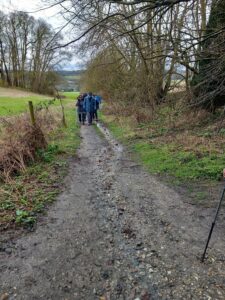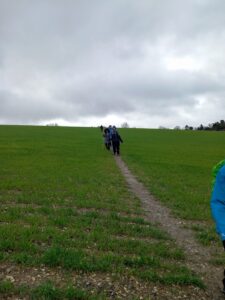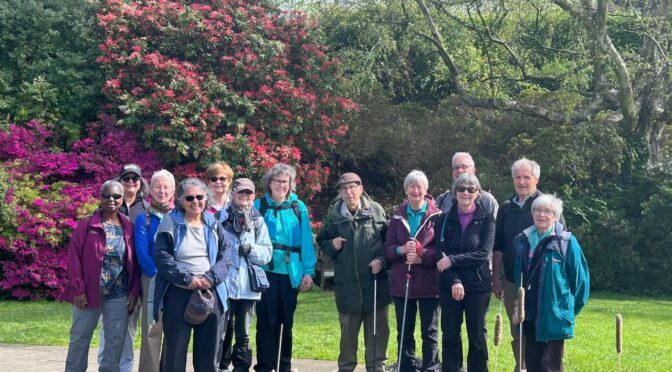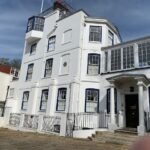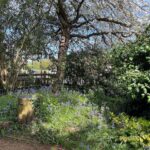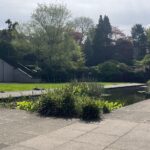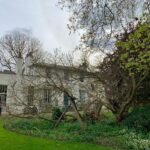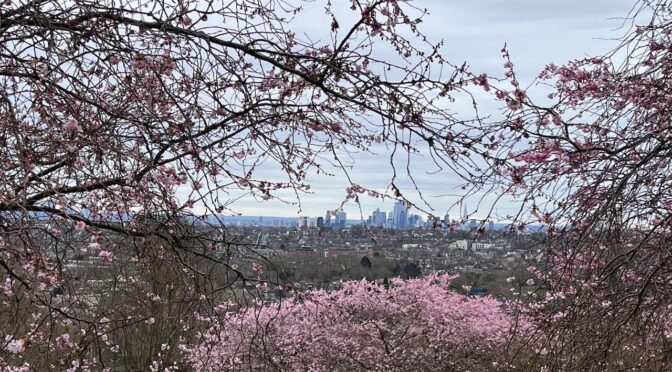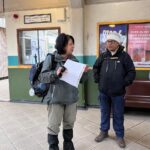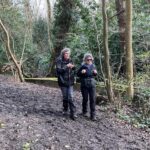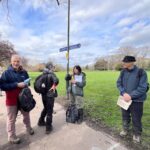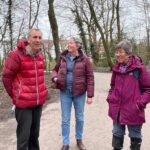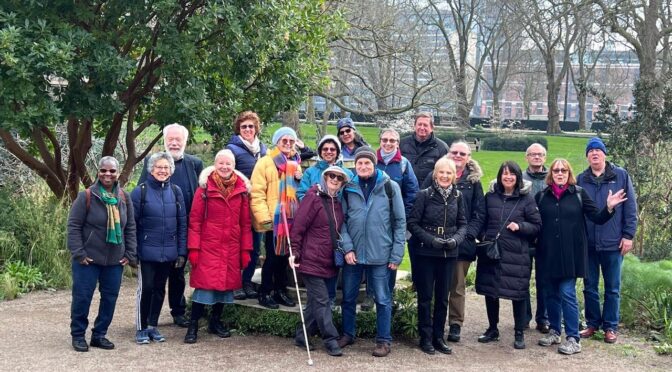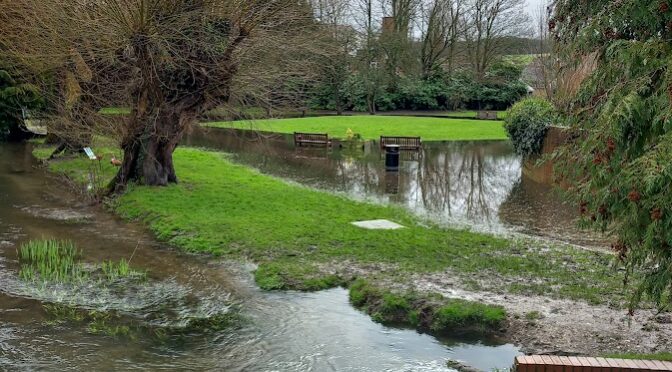We are now half way round the London Loop having started at Cockfosters (clockwise), soon after we came out of Lockdown. Our most recent walk took us from Hamsey Green to Coulsdon South station. It was one of our shorter stages so far, dictated partly by the length of the following stages, and to ensure easy access to trains at start/finish. We had a really good turnout and a lovely, dry and bright day. Continue reading LONDON LOOP: HAMSEY GREEN TO COULSDON SOUTH – 24 MARCH
HAMPSTEAD to HAMPSTEAD HEATH – 14TH APRIL
Fourteen Polyramblers gathered for a walk through Hampstead, welcoming a prospective new member and Hilary on her first outing with us since her accident.
Initially we walked past several sites of interest including Constable’s tomb, Fenton House, Admiral’s House and Whitestone Pond, one of the highest spots in London, before entering the west side of the Heath. We strolled along the wisteria and vine covered Pergola and around the stunning vistas of Hill Garden before reaching the Old Bull and Bush pub where Peter led us in a spirited rendition of the music hall song.
Another stretch of Heath brought us to our lunch spot at Kenwood House where several of us visited the beautiful 18th century mansion with its first-rate art collection whilst others enjoyed the stunning grounds including a magnificent handkerchief tree.
Suitably refreshed ten of us set off to explore the Vale of Health, a magnet for centuries for artists and writers, before a final walk past architectural gems including the Modernist no. 2 Willow Road brought us to Keats House the finish of our walk.
Thanks to Nita, Hilary and Lan for photos.
Jennifer and Chris.
COCKFOSTERS TO HIGHGATE – 16TH MARCH
North to South London Trail Part 1
Twelve Polys congregated at Cockfosters station for the first part of a new route across London from North to South: 34 miles Cockfosters to Carshalton Beeches, taking advantage of the many parks and green spaces. After a short walk through the suburbs, admiring some beautiful magnolia blooms, we negotiated some serious mud descending into the ancient woodland of Oakwood Hill Wood nature reserve where a woodpecker was hard at work in the surrounding trees. We then followed the Pymme’s Brook, a tributary of the River Lea, Trail into Oakhill Park, Brunswick Park and Arnos Park, passing the impressive Arnos Park viaduct built in 1932 when the Piccadilly Line was extended north from Finsbury Park.
We entered Broomfield Park with the remains of its, unfortunately seriously fire damaged, great house. The landscaped grounds with the original Tudor walls remain for the public to enjoy, so we stopped for lunch; either a picnic or delicious cake and coffee at the Palmers Green Community café, run by volunteers. After lunch we continued along the New River Path to Alexandra Palace station via Finsbury Gardens. This is not actually a river but a waterway opened in 1613 to bring drinking water from Hertfordshire to London. One of our members decided to return home from there, while the others took the uphill path to Alexandra Palace.
While we were enjoying a refreshment stop Chris, who fortunately checks his phone more than the leader, informed us that Gillian, Stuart and Pam were walking towards us. We met up with them and were informed that Pam had sent a message advising of her transport issues getting to the start of the walk. The leader was mortified, but Pam was undeterred and had completed the walk starting just slightly behind us. Gillian and Stuart had been on a boat trip to celebrate the latter’s birthday. Now numbering fourteen, we proceeded along the North Parkland Walk and Highgate Wood to Highgate station.
The other 4 sections will be offered on future programmes during the winter months when a walk in London is often convenient due to short days and uncertain weather. The leader also made a promise to ensure she checks her phone properly before setting off!
Susan
Photos by Ida and Rajesh
LONDON’S INNS OF COURT – 7th MARCH
There were two groups of walkers meeting at Temple tube station: Capital Walkers and the Polyramblers. Some Capitals Walkers were attracted to our group, but we had to disappoint them. Anyway, upon checking their programme, I discovered that they were doing an 11-mile walk. Ours was 3 miles but was going to include a lot of interesting stops.
There were 19 of us and our first stop was at Two Temple Place, a beautiful building built for William Waldorf Astor in 1895. It’s not open very often but there is a free exhibition on glass until 21 April so we spent half an hour inside admiring the glass and the building. Then, we started exploring the first two out of four Inns of Court: Inner Temple and Middle Temple, by going through an elaborate archway.
We passed 16th century Middle Temple Hall where Shakespeare’s company performed Twelfth Night in February 1602 and where you can book to eat a very nice lunch Monday to Friday https://www.middletemple.org.uk/lunch . After Middle Temple Gardens, we joined the Strand, passed the premises of Twining Teas and re-entered Temple into Middle Temple Lane. We went into Pump Court and Elm Court and then had lunch in the nice Garden Room Café. We admired Inner Temple gardens and the Hall, Treasury and Library of the Inner Temple. We went into Church Court where Temple Church is situated. It is now famous for the book ‘The Da Vinci Code’ and there is an entry fee unless you go for a service. The round section of Temple Church was built by the Knights Templars in 1185 and the chancel added in the 13th century. It is shared by Middle and Inner Temple.
After a short detour into Hare Court, we went into Chancery Lane, passed the old Public Records Office – which is now part of Kings College – the former Law Fire Insurance Office and the Law Society building. Then it was into Carey Street and the Silver Mousetrap shop (1690), the Seven Stars pub (1602) and the entrance to Lincoln’s Inn. We admired the gardens, hall and library and the Ostler’s Hut, designed by George Gilbert Scott in 1852. It is London’s smallest listed building. It was essentially a porter’s hut. An ‘ostler’ was someone who traditionally looked after horses. The next stop was Lincoln’s Inn chapel undercroft and the beautiful chapel whose foundation stone was laid by John Donne in 1620. We admired the coats of arms of the treasurers of Lincoln’s Inn over the centuries – the Treasurer being the most senior position at the Inn.
AMERSHAM TO CHESHAM – 2 MARCH
I was impressed that 13 Poly Ramblers made the journey to Amersham in the rain this morning for a 4.5 mile walk with guaranteed mud. We headed down to Old Amersham through woods and fields, passing the Martyrs Memorial, last seen on a Club walk in December. We reached the River Misbourne which had burst its banks and engulfed two benches. We wandered along the High Street and admired the historic buildings. At the 17th century Market Hall there was a small market and a few of us were tempted by the cheese stall….. Eventually we headed uphill on a stony path, crossed the railway (no trains!) and entered Hervines Wood. At this point conditions underfoot deteriorated and it would have been useful to have done a walkover but eventually we found our way through the wood to Copperkins Lane. We turned onto Mayhall Farm for the field paths down into Chesham. A large body of water of uncertain depth across the path made me decide to try an alternative route. We probably should have stuck to plan A as the alternative was no better. We passed a playing field and decided to walk across it to avoid some of the mud. Getting out of said field proved to be a bit of a challenge and one member ended up with a muddy bottom! More slippery downhill work until at last we emerged into open fields with views of Chesham. What a relief. We soon hit tarmac and then Chesham town centre where we dispersed to cafes and pubs before making our way home. Thanks to everyone who turned up.
Gillian
